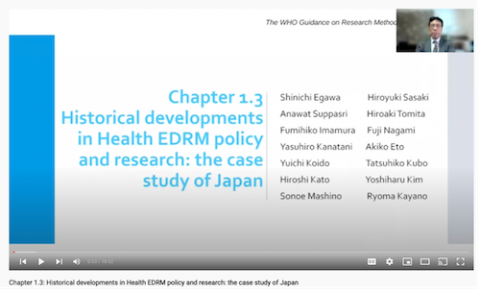Chapter 1.3 Historical developments in Health EDRM policy and research: the case study of Japan

Chapter 1.3 describes the importance of research evidence for health emergency and disaster risk management (Health EDRM) policy and practice, considering Japan as a case study. It aims to describe how to:
- Review historical examples of disaster impact and response relevant to health.
- Discuss how changes in health risks and resilience affect disaster impacts, and how disasters affect health risks.
- Explain improvements in the methods used to assess and minimize health impacts of disasters.
What is this chapter about?
Disaster risk can be difficult to measure and developing appropriate policies to address those risks can be challenging. Case studies can help researchers and decision-makers better understand the relationship between large-scale disasters and policy changes. They can also help by providing learning from the past that will improve Health EDRM in the future.
This chapter uses Japan as a case study to show how the environment for conducting Health EDRM research has improved as a result of historical events and the transformation and expansion of the country’s disaster medical system under legal implementation. These experiences are also relevant to policy and programme development in other countries. The chapter shows how the consequences of past disasters prompted Japanese decision-makers to re-develop their existing disaster response infrastructure. It also describes how Japanese researchers are using data from previous disasters to track ongoing risks and health impacts in affected communities.
Case studies presented in the chapter:
- Using the history of earthquakes and tsunamis in Japan to understand and anticipate the hidden disaster risk in the 21st century.
- Development of a disaster nursing support system and educational mechanism by the Japan Nursing Association after the 1995 Great Hanshin Awaji Earthquake.
- Development of a mental health support system and specialized mental health teams after disasters.
- Development of a long-term mental health support system by establishing mental health centers in disaster-affected areas.
- Development of the J-SPEED disaster health data management system for real-time evidence-based decision making in EMT coordination.
- Cohort studies to evaluate longitudinal effects of the 2011 Great East Japan Earthquake in disaster-affected communities.
- Tohoku Medical Megabank Project to perform long-term follow up with registers and biological data after the 2011 Great East Japan Earthquake.
Authors: Egawa S, Sasaki H, Suppasri A, Tomita H, Imamura F, Nagami F, Kanatani Y, Eto A, Koido Y, Kubo T, Kato H, Kim Y, Mashino S, Kayano R.

